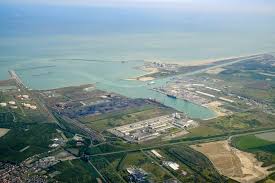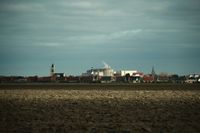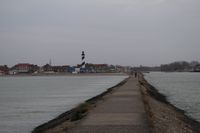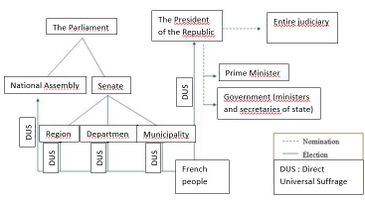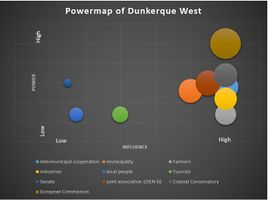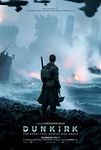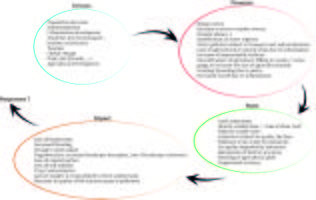COLAND Case Study 2020 - Dunkerque (West): Difference between revisions
No edit summary |
|||
| Line 84: | Line 84: | ||
=== Actors and stakeholders === | === Actors and stakeholders === | ||
Our area covers the borough of Dunkirk as well as the borough of Saint-Omer. In this area, we are dealing with a group of municipalities called "Dunkerque Grand Littoral". This inter-municipal cooperation brings together 17 municipalities and its competences revolve around economic development, waste management, town planning, mobility and transport, energy, water management and sanitation, housing and roads. Finally, it intervenes in the fields of health, sport, justice, education, major risks and accessibility. This cooperative is managed by a President and its Vice-Presidents. This cooperation can therefore be considered as the leading player in the area. In the commune of Saint-Omer, which represents only a small part of our area, we find the Platier d'Oye national nature reserve. It is managed by the EDEN 62 mixed syndicate, which brings together, on an equal footing, elected members of the Departmental Council and local authorities. This syndicate is a will of the Pas-de-Calais Department and its missions are to protect, develop and raise awareness.' | Our area covers the borough of Dunkirk as well as the borough of Saint-Omer. At the European level, the European Commission has drafted numerous directives and laws to try to protect the coasts and shorelines. At the national level, we have the Conservatoire du Littoral which manages a third of its coastline. Our area covers the borough of Dunkirk as well as the borough of Saint-Omer. In this area, we are dealing with a group of municipalities called "Dunkerque Grand Littoral". This inter-municipal cooperation brings together 17 municipalities and its competences revolve around economic development, waste management, town planning, mobility and transport, energy, water management and sanitation, housing and roads. Finally, it intervenes in the fields of health, sport, justice, education, major risks and accessibility. This cooperative is managed by a President and its Vice-Presidents. This cooperation can therefore be considered as the leading player in the area. In the commune of Saint-Omer, which represents only a small part of our area, we find the Platier d'Oye national nature reserve. It is managed by the EDEN 62 mixed syndicate, which brings together, on an equal footing, elected members of the Departmental Council and local authorities. This syndicate is a will of the Pas-de-Calais Department and its missions are to protect, develop and raise awareness.' | ||
Then the second player would be represented by the various mayors of these 17 communes. They play a double role: ''state agent and commune agent''. As an ''agent of the state'', the mayor fulfils the following administrative functions: | Then the second player would be represented by the various mayors of these 17 communes. They play a double role: ''state agent and commune agent''. As an ''agent of the state'', the mayor fulfils the following administrative functions: | ||
Revision as of 14:54, 19 February 2020
>>>back to working groups overview
Rationale
This case is a perfect illustration of the location of industries in a very natural landscape, where conflicts between the two exist and where compromises must constantly be found. Today, we can see that attempts are being made to protect certain areas in order to conserve the fauna and flora specific to this type of environment, while at the same time continuing to develop the port industry, which occupies an important part of the landscape, especially along the coast. It is therefore interesting to analyse this situation and find solutions to reconcile these different issues in the landscape.
Location and scope
You can edit this map with the map editor
A Landscape System Analysis
A.1 Landscape layers and their system context
Geomorphology, landscape units and coastal typology
From a geomorphological point of view, the territory has been influenced by two dominant factors: the maritime regime (the English Channel/North Sea) and hydrography. The area is part of the maritime or alluvial plain known as the Flemish maritime plain, which continues towards Belgium and the Netherlands. Its boundaries are defined by the former Aa delta. This type of geomorphological formation indicates that the area is highly marked and is changing noticeably as a result of the more or less rapid sedimentation phenomena. According to the geology map, we are faced with a recent Quaternary formation characterized by two fundamental typologies: dune formations and bay sealing sediments (sand and mud). The coastline has no hard formation at any point and is therefore very unstable on a human scale. To the north, the Channel's course narrows to only 35km, which has an influence on the sedimentary regimes. The foreshore is highly developed west of Dunkirk between 1000 and 1500m wide and the dune formations along the coastline reach 500 to 1000m wide. The morphology of the seabed influences the sedimentation and erosion mechanisms along the coast. The topography of the seabed is dominated by the presence of the Bancs de Flandres. They provide some protection for the coast by absorbing some of the energy of the swells. The evolution of the coastline is due to erosion and sedimentation phenomena, whether natural (wind, swell, tide) or anthropogenic (dyke, urbanisation, canal, etc.). From Calais to Dunkirk, the coastline has tended to become rather fatter, with the shoreline growing by around 500 m over the last 300 or 400 centuries. This is due to several factors, including the welding to the shore of the sandy banks encountered in front of the coastline. In particular, the closure of the Mardyck channel, which was favoured by the construction of the Dunkirk jetties, has led to a significant advance in the shoreline. The current coastal regime is, to a large extent, the legacy of changes in the seabed and coastline that have taken place during these sea level variations.
On the coast, swells have a predominant action on sedimentation, while offshore, currents have a predominant action on sedimentation. The action of the swells is translated by a lateral transport (coastal transit) but also by a sorting in the profile which results in a decrease of the granulometry of the coast to the bottom. The distribution is done as such: where the currents are strongest, the materials are the largest and where they are weakest, the sediments are the finest.
The progression of the coastline to the east is the result of a natural phenomenon accentuated by the construction of dykes in order to gain land. The harbour piers, which acted as groynes, prevented the movement of sediment and caused the beaches east of Dunkirk to become thinner and west to become fatter. Over time the surface area of the dune cord has shrunk considerably. The development of urbanization is the main cause (40%). The remaining dunes have also lost height. From the landscape point of view, this maritime plain, also called "Bootland" (bare country), is characterized by a little marked relief whose altitude is lower than 5m for the majority. The landscape is open and strongly exposed to the wind, added to its agronomic richness, there is little afforestation. There are therefore large areas of open cultivation, beets, chicory, flax, vegetables and cereals. It is criss-crossed by polders and an extensive network of canals whose flow is constantly regulated. It is separated from the North Sea by a dune strip. This physical characteristic explains the ease of urban development (no relief hindrance). The natural orientation of the territory thus dictates the organisation of human settlements, which are part of this network (infrastructures, urbanisation, etc.). There are two major landscape entities: the dune belt and the channelled maritime plain. The channelled maritime plain is the result of strong human intervention in its environment. In the Middle Ages, the plain was polderised, then the marshes were drained from the 12th century onwards through the setting up of the watering system. From the period when the territory was only sea, the landscape keeps strong characteristics: the horizons, the wind, the presence of water, which make it a landscape in transition, between land and sea. Successive urbanisations, the installation of port facilities on the seafront, the development of infrastructures, have modified the legibility of these large geographical entities, thus introducing strong ruptures.
The beach and dune areas bear witness to the original landscape of the seafront. They are characterized by a high ecological richness (ZNIEFF, SIC) and a landscape of meadows and sand dunes.
- Yourcase landscapeunits1.jpg
add a caption
- Yourcase landscapeunits2.jpg
add a caption
Land use
The land use of West Dunkirk is mainly made up of two matrixes, which are almost equally distributed on the ground. The first matrix is an urban matrix. Compared to the urban matrices observed in Belgium, the French urban matrix is denser. Indeed, in the region of West Dunkirk , we find three denser urban poles (in red) corresponding to Dunkerque in the East, Grand-Fort-Philippe and Gravelines in the West and Loon-Plage in the centre. As Dunkirk is the main town on this stretch of the coast, a sub-prefecture of the department of Northern France, it is the one that is experiencing the greatest sprawl with the addition of industrial and commercial zones (in purple) in its periphery. These areas, beyond the importance of the city of Dunkirk, have also developed due to the importance of the port of Dunkirk (in grey) which has developed over almost all of this part of the coast. This port is an essential economic point for France since it provides a direct connection with Great Britain, but also because of its strong energy vocation. The rest of the surface area of this stretch of coast is essentially made up of an agricultural matrix (in yellow) composed of numerous small and complex plots of land, most of which are used for cereal crops. Although little represented on the whole territory, there is nevertheless a forest patch to the south-west of Dunkirk (in green).
Green/blue infrastructure
- What are the major potential elements of a green/blue infrastructure network? Are these likely to change/disappear? Why is that?
- You find my background material on green infrastructure in our reading list
- add 1-2 graphical representations to the image gallery, you can add more if you like
- Your case green blue infrastructure1.jpg
add a caption
- Your case green blue infrastructure2.jpg
add a caption
Actors and stakeholders
Our area covers the borough of Dunkirk as well as the borough of Saint-Omer. At the European level, the European Commission has drafted numerous directives and laws to try to protect the coasts and shorelines. At the national level, we have the Conservatoire du Littoral which manages a third of its coastline. Our area covers the borough of Dunkirk as well as the borough of Saint-Omer. In this area, we are dealing with a group of municipalities called "Dunkerque Grand Littoral". This inter-municipal cooperation brings together 17 municipalities and its competences revolve around economic development, waste management, town planning, mobility and transport, energy, water management and sanitation, housing and roads. Finally, it intervenes in the fields of health, sport, justice, education, major risks and accessibility. This cooperative is managed by a President and its Vice-Presidents. This cooperation can therefore be considered as the leading player in the area. In the commune of Saint-Omer, which represents only a small part of our area, we find the Platier d'Oye national nature reserve. It is managed by the EDEN 62 mixed syndicate, which brings together, on an equal footing, elected members of the Departmental Council and local authorities. This syndicate is a will of the Pas-de-Calais Department and its missions are to protect, develop and raise awareness.'
Then the second player would be represented by the various mayors of these 17 communes. They play a double role: state agent and commune agent. As an agent of the state, the mayor fulfils the following administrative functions: - the publication of laws and regulations - the organisation of elections - the legalization of signatures. It may be responsible for the execution of general security measures. As an agent of the municipality, he is responsible for the execution of the decisions of the municipal council and acts under the control of this council. He represents the municipality in court, awards contracts, signs contracts, prepares the budget, and manages the assets. In the area of town planning, he issues building permits and other town planning authorisations on behalf of the municipality. By its municipal by-laws, it can regulate traffic, parking, bathing and navigation in its municipality or prescribe works in case of endangerment of the population or the environment.
Finally, the third and last actor is the people living and working in the area, not forgetting tourists. Thus, we find the port of Dunkirk and all the workers associated with it. It should be noted that this port is classified as France's 3rd largest port, renowned as a port for large bulk goods destined for its many industrial establishments. In other words, it plays an essential role in the landscape. There are also many commercial zones within our study area, which also impact the landscape. The farmers who structure the landscape with their plots of land cannot be overlooked either. Finally, let us not forget of course the inhabitants who live the landscape on a daily basis, as well as the tourists who impact the landscape to a greater or lesser extent depending on their presence.
So it can therefore be said here that it is the inhabitants and workers (mainly farmers) who are affected by the changes made to the landscape. Nor should we forget the local fauna and flora that depend on the actions initiated in the landscape. Hence the importance of having protected areas such as the Platier d'Oye Nature Reserve.
Sacred spaces and heritage
- Which places/elements hold cultural value and to whom?
- You may add a map and some images, please also explain in your caption why these elements are valuable
- Your case sacredspace1.jpg
add a caption
- Your case sacredspace2.jpg
add a caption
- Your case sacredspace3.jpg
add a caption
Visual appearance and landscape narrative
- This landscape was represented by several Dunkirk painters such as Mathieu Elias and Philippe de Corbehem in the 17th century. However, it is more of interest to travellers. In the first half of the 19th century, Jean-Baptiste Camille Corot produced several Romantic-style oil paintings such as "Dunkerque, vue du port de pêche (1873)" or "Dunkerque plein air" which illustrate an idealized vision of fishing and small houses in the dunes as far as the eye can see. At the end of the century, there were still a few less numerous representations of the dune landscape such as the oil on canvas "Dunkerque" inspired by the Realism of Marie-Thérèse VanKerk. At the beginning of the 21st century, lighthouses become one of the most appreciated subjects in contemporary work. Thus, we find "Phare de Saint Pol" by Pascal Leroux in 2004, "Phare de Dunkerque" by Alain Depieretti in 2011 or "Phare Saint-pol" by Brigitte Bodo.
- Some people have written about Dunkerque. In his epistolary account "France and Belgium, Alps and Pyrenees, travels and excursions" published after his death in 1892, Victor Hugo wrote letters to his wife Adèle, recounting his journey. In particular, he talks about his stay in Dunkirk. A second work "Dunkerque - Un port, des villes, un littoral, un siècle d'aventure urbaine" by Collectif Maurice Culot.
- There is also a movie "Dunkirk" by Christopher Nolan, released in 2017, dealing with the Second World War, parts of which, particularly in the dunes, were shot in Dunkirk. This landscape inspire also singers like Alain Souchon in the song "Le Baiser".
- The Dunkirk landscape was abundantly painted in the 18th century. There are numerous oil paintings in the Romantic style, depicting picturesque dune and maritime landscapes showing an idealized vision of fishing and life on the coast. In addition to painters, this landscape has also inspired poets, singers, and writers, such as Victor Hugo, during their visits. Over time, we notice that the subject matter of the works has changed to focus more on built and architectural elements such as the Saint-Pol lighthouse, which has been depicted several times in contemporary works. The Second World War played a very important role, loading the landscape with history. Several texts have been written on the subject and the better known film Dunkerque illustrates this event. Since the 19th century, the landscape has been much less represented. One can hypothesize that the establishment of industries has caused the picturesque side of the place to be lost.
A.2 Summary of your landscape system analysis and your development targets
We found that the major drivers of our DPSIR model were related to urbanization and climate change and industry development. These different drivers put pressure on the coastal landscape, human well-being and the specific biodiversity in place. There is already fragmentation of the territory, a decrease in water and air quality, and strong erosion of the dune belt, which could worsen over the years without intervention to reduce these pressures.
The disappearance of natural areas affects the quality of life of the premises and therefore has an effect on point 3 "Good Health and Well-Being". Rising water levels can salinise the ground water on land and thus limit access to fresh water for cultivation. There is therefore an effect on point 6 "Clean Water and sanitation". The presence of oil platforms in the maritime environment and a major nuclear power plant shows us that energy from the coast is not green energy. However, it remains affordable in accordance with point 7 "Affordable and clean energy". In compliance with point 9 Industry, Innovation and Infrastructure', the port of Dunkirk continues to develop. However, this has a negative impact on point 11 "Sustainable cities and communities" since the extension of port activities tarnishes the landscape and makes it less attractive due to the concentration of functions and their lack of multiplicity. The region ends up being neglected because the coastline loses its attractiveness. Tourism also suffers from this loss of attractiveness and endangers point 15 "Life on Land". Point 13 "Climate Action" is one of the points most at risk. Indeed, little action is being taken on the coast, despite the climate emergency. The region is therefore suffering a loss of biodiversity (which also affects point 15 "Life on Land") due to the gradual disappearance of the dune barrier and the high risk of disappearance of wetlands of a special nature due to future submersion. Point 14 "Life Below Water" is also affected by river and sea traffic. The densification of this traffic due to the increase in the port goes against the recommendations of the UN. Finally, point 17 "Parnerships for the goals" may seem to be intact due to the establishment of a European Commission, but the lack of legislative power of the Commission and the lack of consistency in the way the coastal landscape of the different countries is treated (not the same legislation, not the same recommendations) endangers the coast as a whole.
In relation to the analysis carried out according to the DPSIR model and in relation to the UN sustainable development objectives that have been observed to be at risk, we have identified two major issues concerning our territory. The first is related to the reduction of the natural environment and its loss of biodiversity. Indeed, due to the erosion of the dune barrier, the extension of the port, aggressive mobility and rising water levels, landscapes specific to this region are disappearing, leading to the disappearance of species typical to these environments. The second is more anthropogenic. The impoverishment of the quality of the environment, caused by the extension of the port and the coastal industry and a specialisation of functions (lack of diversity) impacts on human well-being and leads to a loss of interest in the region and in the development of its tourism.
- Are there any existing initiatives taking action in this landscape? Do you have a critical perspective on that?
- Add text and visuals
A.3 Theory reflection
International : Guiding Principles for Climate City Planning Action These guiding principles provide a common reference point. It permit to give a global response to climate change by curbing their greenhouse gas emissions and adapting to the effects of a changing climate mainly of cities.
Organisation : • strengthening government capacity • involving local communities and multi-stakeholders • ensure transparency of the process of participation • choosing priorities actions over the short, medium and long term • developing a strategy
Planning process : • Effective mitigation and realisation of baseline inventories and assessments • Ambitious target-setting and good synergies developing • on-going process and evaluation
The result is the planning of climate action in cities through the creation of stand-alone plans or the integration of climate action into ongoing planning processes.
EU : Water and Marine Policy
On 12 March 2013, the commission adopted draft proposals for directives aimed at establishing a framework for maritime spatial planning and managing coastal integration, with a view to the sustainable development of coastal zones. This document thus contributes to the implementation of several other Community policies related to marine and coastal areas. These include, for example, the Habitats and Natura Directives and the Urban Strategy Framework Directive. Of course, there are many others.
France : The Coastal Law
The Coastal Law is a law adopted in 1986 by France that provides a framework for coastal development. It concerns nearly 1200 communes bordering the sea. In the face of urban pressure, erosion or marine submersion phenomena suffered by these territories, it attempts to reconcile preservation and development of the coastline. The main objectives of this law are to preserve natural areas, develop economic activities linked to the proximity of water, set up a graduated protection, allow a sustainable development of the territories, leave the possibility to adapt to the territory and reinforce research and innovation.
A.4 References
- give a full list of the references you have used for this section
Phase B: Landscape Evaluation and Assessment
B.1 Assessment Strategy
- Based on the hypothesis derived from your previous landscape systems analysis you are now asked to define the goals for assessing the landscape. Your assessment is the basis for evaluating the landscape status.
- Which elements and phenomena need to be mapped, why and how?
- This a text contribution, max 250 words
B.2 Mapping
- As defined by your assessment strategy you conduct the mapping and present your findings here
- As a minimum, at least three different themes need to be mapped, you may choose more if needed
- Your case your assessment mapping themel.jpg
briefly explain the findings of your mapping
- Your case your assessment mapping theme2.jpg
briefly explain the findings of your mapping
- Your case your assessment mapping theme3.jpg
briefly explain the findings of your mapping
B.3 Problem definition and priority setting
- Give a summary of the major findings of your mapping process, what are the problems/potentials identified?
- Draw a problems/potentials map
- Set priorities for the most relevant issues
- Your case problems potentials map.jpg
add caption here
B.4 Theory reflection
- Please reflect the assessment and evaluation methods used based on at least three readings
- Did you encounter limitations'
- 200 words test contribution
B.5 References
- give a full list of the references you have used for this section
Phase C – Strategy and Master Plan
C.1 Goal Setting
- Define strategic planning objectives based on the evaluation findings
- Link back to your original targets from section one and the Development Goals
- 150 words text contribution
C.2 Spatial Strategy and Transect
- translate your strategic goals into a vision
- develop a spatial translation of your vision
- exemplify your vision in the form of a transect with concrete interventions
- add map(s) and visualizations
- Your case spatial translaton vision.jpg
add caption here
- Your case transect.jpg
add caption here
- Your case transect detail1.jpg
add caption here
- Your case transect detail2.jpg
add caption here
C.3 From Theory of Change to Implementation
- For implementing your vision: Which partnerships are needed? Which governance model is required?
- Who needs to act and how? Draw and explain a change/process model/timeline
- Which resources are needed? On which assets can you build?
- add 150 words text and visuals
- Your case spatial your governance model.jpg
add caption here
- Your case spatial your process model.jpg
add caption here
C.4 References
- give a full list of the references you have used for this section
D. Process Reflection
- Reflect in your intercultural and interdisciplinary team on the outcomes of your study
- Which limitations were you facing?
- What have you learnt from each other?
- What would you do differently next time?
- You can also use diagrams/visuals
- 250 words text
